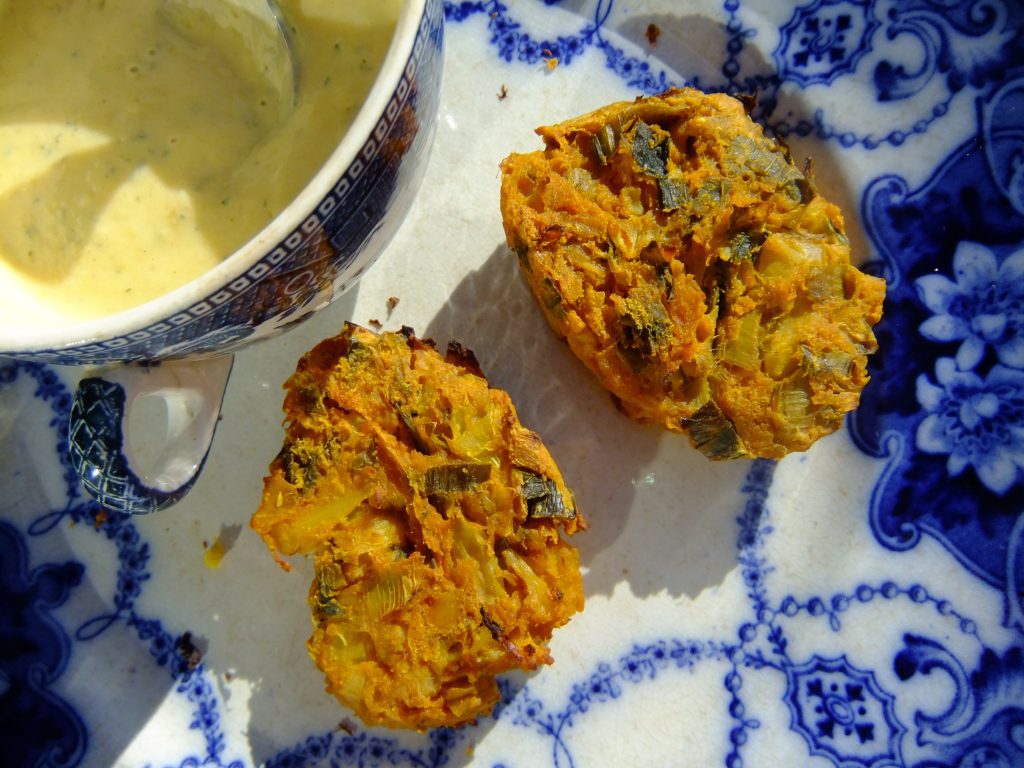I’ve been craving bhajis that are not deep-fried and finally got my wish with this lovely oven-baked recipe. This recipe is slightly adapted from one by Susanna Booth in the Guardian. Great for a buffet, finger food for a party, as a starter, or cold for a picnic. Everyone’s happy to eat it and take seconds. They
don’t need to know that its both gluten-and dairy-free! I like these just as much cold as hot.
NB some mango chutneys contain malt vinegar, which contains gluten, so read the label carefully before you buy.
Makes 15-20
For the bhajis
300g cauliflower
2 medium leeks, green and white parts
1 tbs olive oil (or, even better, virgin coconut oil)
100 gram (chickpea) flour
1 rounded tsp (teaspoon) ground turmeric
1 level tsp ground coriander
1 level tsp ground cumin
A pinch of Himalayan or Atlantic Sea Salt
80ml water
2 tsp mango chutney (make sure it’s a gluten-free one that does not contain malt vinegar) OR 2 rounded tsp St Dalfour or Follain no added sugar apricot jam and a pinch of ground ginger OR 2 tsp unsweetened mango puree (you can do this by blitzing the mango for the dip and reserving 2 tsp for the actual bahjis).
2 rounded tsp tomato puree
Olive oil (or even better, virgin coconut oil) for greasing the baking tin
For the dip
100g natural soya yoghurt (or natural yoghurt or thickened kefir for for milk-eaters)
Half a ripe mango
1 rounded tbs (tablespoon) mango chutney (again, make sure it’s gluten-free)
5 fresh large mint leaves
1. Preheat the oven to 180C. Wash and prepare the cauliflower and leeks. Dice the cauli into tiny pieces; cut the leeks lengthways and then into thin slices. Sweat all the veg in the olive oil in a heavy bottomed pan, covered with a lid, for 5-10 minutes until just softened.
2. Put the gram flour, spices and salt in a bowl. Add the water, chutney and tomato puree and mix to a smooth paste. Add the sweated vegetables and stir until everything is well coated. It will be very thick.
3. Drizzle a little olive oil over a taking tray. Rub with a spatula or brush to coat the whole surface.
4. Dollop the bhaji mix on the tray 1 tbsp at t time. Flatten them a little with the back of a spoon, spatula or fishslice.
5. Bake for 10-15 minutes until slightly browned. Take the tray from the oven, then flip each bhaji over using a fish slice. Bake for another 10-15 minutes until golden. You can eat them hot or cold.
6. Make the dip by blitzing the chutney, mango, mint and yoghurt together in a mini food processor or else use a bowl and stick blender. Refrigerate for up to a day before serving.
Variation:
I made an imitation mango chutney for this recipe by mixing a few things I had in the cupboard: 1 1/2 tbs St. Dalfour apricot jam, a pinch of onion salt, a large pinch of each of dried garlic and ground coriander and 1/2 teaspoon of distilled or wine vinegar.
Why this is better for you:
Gram (chickpea) flour is a good source of protein to help keep you feeling fuller for longer. Leeks are rich in inulin, which helps feed good gut bacteria. Good bacteria are important for all aspects of your health from weight management to clear skin and good digestion and absorption of nutrients. Because these bhajis are baked rather than deep fried which means they don’t toxic heated polyunsaturated oils. In cooking, coconut oil is even better for you then olive oil. This is because coconut oil is less damaged by heating then olive oil. coconut oil is rich in medium chain triglycerides, which can help boost energy because the body digests them very easily. Amazingly, coconut oil is used by your body directly to make energy rather then being stored as fat in your body. This makes it a better tool for weight management than many other oils. Herbs and spices such as turmeric, cumin and coriander have well-documented anti-inflammatory properties and a great health boost for anyone who cares about their health, fitness or skin.


